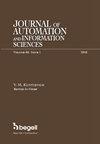FACTORS AND LEVELS ON DESIGN OF EXPERIMENT, EFECTIVE CHOICE UNDER CONSTRAINS
Q3 Engineering
Journal of Automation and Information Sciences
Pub Date : 2021-11-01
DOI:10.34229/1028-0979-2021-6-12
引用次数: 0
Abstract
The problem of design of experiment with resource constraints is investigated. For a complex system intended for experimental research, before using the well known advanced methods of factorial design, you must first create a simplified mathematical model that represents an incomplete abbreviated description of the system. At the same time, on this simplification from all objectively existing independent parameters of the system remain only the most important parameters, which is a forced procedure due to the natural limitations of the resources available to perform the experimental study. The same constraints limit the number of values assigned to each of the parameters (factor levels number). The article is devoted to the modification of the existing method of discretization of such a model with a rational choice of discretization parameters in accordance with the existing limitations, but with an extremely unreliable in terms of convergence iterative solution procedure. The main ideas of the modified approach are as follows: 0) The choice of the number of levels of factors is proportional to the importance of the relevant parameters and the reduction to the problem of finding a fixed point (as in the known method). 1) Probability partition (instead of partition into equal length intervals) for discretization and selection of representative values of the parameter, which allows to find an exact simple expression for its Shannon entropy. 2) Transition from multi- to one-parameter (coefficient of proportionality as an indicator of parameterization) representation of nonlinear mapping, its decomposition and simplification of the iterative process. 3) Finding the initial value of the coefficient of proportionality for a factor with average relevance and calculations for other factors, followed by iterative refinement. The iterative process is guaranteed to coincide, because the consideration of small and large values of the scalar parameter allows us to use the theorem on the intermediate value of a continuous function. Then, with the help of the developed procedure, two tasks on the assignment of the number of factor levels for situations with small and large resource constraints are solved, the corresponding complications in the calculations and ways to overcome them are indicated.实验设计的因素与水平,约束下的有效选择
研究了资源约束下的实验设计问题。对于用于实验研究的复杂系统,在使用众所周知的高级析因设计方法之前,必须首先创建一个简化的数学模型,该模型表示系统的不完整缩写描述。同时,在这种简化过程中,从所有客观存在的系统独立参数中只保留了最重要的参数,这是一个强制性的过程,因为可用于进行实验研究的资源自然有限。相同的约束限制了分配给每个参数的值的数量(因子级别数)。本文致力于对这种模型的现有离散化方法进行修改,根据现有的局限性合理选择离散化参数,但在收敛迭代求解程序方面极不可靠。修改后的方法的主要思想如下:0)因子级别的数量的选择与相关参数的重要性成正比,并简化为寻找不动点的问题(如已知方法)。1) 概率划分(而不是划分为等长区间)用于离散化和参数代表值的选择,这允许为其Shannon熵找到一个精确的简单表达式。2) 非线性映射从多参数到单参数(比例系数作为参数化指标)表示的转换,其迭代过程的分解和简化。3) 为具有平均相关性的因素找到比例系数的初始值,并对其他因素进行计算,然后进行迭代细化。迭代过程是保证一致的,因为考虑标量参数的大小值允许我们使用关于连续函数的中间值的定理。然后,在所开发的程序的帮助下,解决了在资源约束较小和较大的情况下分配因子级数的两项任务,指出了计算中相应的复杂性和克服它们的方法。
本文章由计算机程序翻译,如有差异,请以英文原文为准。
求助全文
约1分钟内获得全文
求助全文
来源期刊

Journal of Automation and Information Sciences
AUTOMATION & CONTROL SYSTEMS-
自引率
0.00%
发文量
0
审稿时长
6-12 weeks
期刊介绍:
This journal contains translations of papers from the Russian-language bimonthly "Mezhdunarodnyi nauchno-tekhnicheskiy zhurnal "Problemy upravleniya i informatiki". Subjects covered include information sciences such as pattern recognition, forecasting, identification and evaluation of complex systems, information security, fault diagnosis and reliability. In addition, the journal also deals with such automation subjects as adaptive, stochastic and optimal control, control and identification under uncertainty, robotics, and applications of user-friendly computers in management of economic, industrial, biological, and medical systems. The Journal of Automation and Information Sciences will appeal to professionals in control systems, communications, computers, engineering in biology and medicine, instrumentation and measurement, and those interested in the social implications of technology.
 求助内容:
求助内容: 应助结果提醒方式:
应助结果提醒方式:


